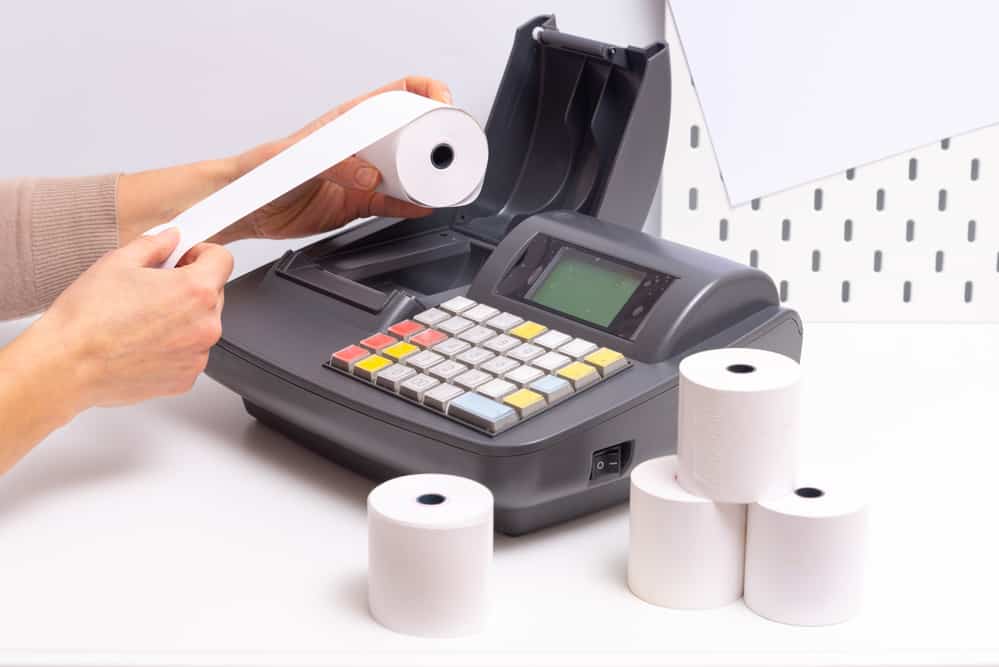This post may contain affiliate links, which means that we get commissions for purchases made through such links, at no additional cost to you. As an Amazon Associate we earn from qualifying purchases.
All printers need certain supplies to keep running but do thermal printers need ink? This question may sound strange to you if you think all printers use ink. In this article, we will share the basic thing you need to know about thermal printing technology, particularly whether they use ink or not.
Do thermal printers need ink? Thermal printers don’t need ink. They operate without ink cartridges or toners. Instead, they use a special technology that employs heat as the print agent. In thermal printing, heat would either react directly with the paper or melt thermal ribbons on it to produce imprints. This depends on whether you are using direct thermal or thermal transfer printing.
You may be wondering how heat can be used to produce imprints. How about the two types of thermal printing we mentioned above? What do they mean? How do they work? How is one different from the other? How are thermal printers different from ink-based printers? Is it better to print with or without ink? We will explain these and many more as you read on.

Why Don’t Thermal Printers Need Ink?
Thermal printers don’t need ink because it was designed to print on heat-sensitive papers or with thermal ribbons. Direct thermal printers use heat-sensitive label rolls whose ink pigments are activated by heat to produce imprints. Thermal transfer printers, on the other hand, work with thermal ribbons whose ink pigment melts under heat and transfer to the paper.
While the printhead of ink-based printers release ink to print on the media, the thermal printhead simply emits heat. This invention is now the go-to option for many businesses that issue tickets and receipts, among other thermal prints and labels out there.
In the next section, we will give you a more detailed explanation of how the two types of thermal printers work.
How Do Direct Thermal Printers Work Without Ink?
The direct thermal mechanism works with special paper, called thermal papers. These papers will produce an imprint on any spot where heat is applied because they contain heat-sensitive chemicals. Heat activates these chemicals to produce imprints.
So when you feed a thermal paper roll into your direct thermal printer, it runs through the printhead. As each thermal sheet touches the printhead, heat will apply to the specific spots where printing should occur. On those spots, heat would activate the chemicals and cause the spot to darken.
The problem with thermal papers is that the entire paper remains active even after you are done with printing. This means that other spots on the paper can still be activated by heat. That is why direct thermal receipts and labels damage due to heat exposure. As such, direct thermal printing is only suitable for retail receipts, shipping labels, wristbands, tickets, ID badges, and other short-term items.
How Do Thermal Transfer Printers Work Without Ink?
Thermal transfer printers use heat too, but they do not apply heat directly to the paper. Instead, they use thermal transfer ribbons. There are different ribbon colors available but thermal transfer printers can only accept one ribbon per time. The printer would apply the color of the ribbon on the entire print on a continuous-fed sheet supply.
The outputs of thermal transfer printing are generally good for archiving and can withstand extreme environments. More so, while direct thermal printers mostly use paper material, thermal transfer printers print on diverse print materials, including plastics and polyester.
Thermal Transfer Ribbons
There are different types of ribbon materials with various degrees of strength and durability. The different ribbon types have different levels of resistance to heat, cold, UV light, chemicals, wear, and moisture. They are as follows:
Wax Ribbons
Wax ribbons print at high speeds and consume less energy because they melt under low heat. They can withstand some friction but cannot hold up to chemicals.
Wax/Resin Ribbons
These ribbons print at a slower speed but they can print on synthetic surfaces, including matter and coated paper. They offer smear and scratch resistance and can hold up to some chemicals. However, harsh chemicals will destroy them.
Resin Ribbons
This is the highest quality of thermal transfer ribbon available. It doesn’t print as fast as the other ribbon types but it offers more media options. It is compatible with glossy surfaces and can resist friction, harsh chemicals, outdoor environments, and extreme temperatures.
Benefits of Using Ink-free Thermal Printers
Generally, thermal printing is easier to use. With just a few clicks, you will accomplish your printing in no time. More so, they work very quietly and produce quick prints. And since they don’t require ink, the only supplies you need to purchase are the thermal paper rolls.
Since thermal printers are inkless, you don’t have to wait for the ink to dry after you have printed the label. This means there is less risk of smearing, which is good for a wide variety of applications. In the end, if you are running any kind of business, you would need thermal printers to issue on-the-spot receipts. You can also use them to print labels, tags, and tickets.
✅ Video – Easy to understand how Thermal printer works
Check out this video to understand the ink-free mechanism of thermal printers, as well as how thermal ribbons work. You will see a live demo of how the thermal printers transfer ink from the ribbon to the label. It also highlights how to set and replace paper rolls on thermal printers.
Differences Between Ink-based and Thermal Printers
Both ink-based and thermal printers are versatile but they have distinct differences beyond their printing mechanism. Ink-based printers produce labels or higher quality but thermal printers are cheaper and often last longer. They are also faster than ink-based printers.
Some of these primary differences are as follows:
Image Quality
Ink-based printers generally produce high-quality images and offer a wide variety of colors. However, thermal transfer images offer higher color saturation.
Lifespan
Thermal printers last longer than ink-based printers because you don’t have to move their parts as often as the ink-based varieties. They also have a shorter downtime.
Costs
Thermal printers cost more than comparable ink-based printers upfront but the investment is worth it since they are usually very durable. However, thermal ribbons are also costlier than ink cartridges.
Print Speed
Thermal printers have a significantly faster print speed. So they are better options for bulk printing runs than ink-based printers.
Medical Applications
Thermal transfer printers are optimal for printing on medical-grade polyethylene. Ink-based polyethylene, on the other hand, is not ideal for medical applications.
Related Questions
Do Thermal Printed Papers Fade?
The images and characters on thermal papers will eventually fade. But how long it takes for that to happen will depend on how you handle and store the thermal paper. Exposure to certain elements can make the prints fade faster. These include UV light, heat, and moisture.
Remember that direct thermal papers are coated with heat-sensitive chemicals, which causes the paper to darken under heat. After printing, if you expose the paper to heat, it would degrade the print. As for thermal transfer printers, wax ribbons might melt under heat and affect the print.
How To Stop Thermal Receipts From Fading?
Your thermal receipts can remain legible for some years if you store them appropriately. The proper storage condition for thermal prints is to store them in cool, dark, and dry places, away from light and heat. You should also store them away from plastic sleeves.
Any temperature above 140 Fahrenheit will affect thermal prints. So if you leave them outdoors or on your car’s dashboard with your windows wound up, the temperature in your car would rise to the point that it starts discoloring your thermal paper.
How Do You Fix Faded Thermal Paper?
To fix a faded thermal print, you can reapply low-level heat to make the print appear again. This method works because thermal papers use heat rather than ink. One way to reapply heat is to use your handheld hairdryer. Set the heat level on mid-heat and let the air blow gently towards the thermal receipt. The text would gradually become visible again.
Any source of low heat will make the print reappear again. Aside from a handheld hairdryer, you can also use light bulbs and other low-heat sources.
Conclusion
As you have seen, thermal printers don’t need ink. Thermal papers use heat-sensitive papers only while thermal transfer papers use heat to melt ribbons on labels. Both methods use thermal printing technology and are inkless. They are faster and last longer than ink-based printers.
